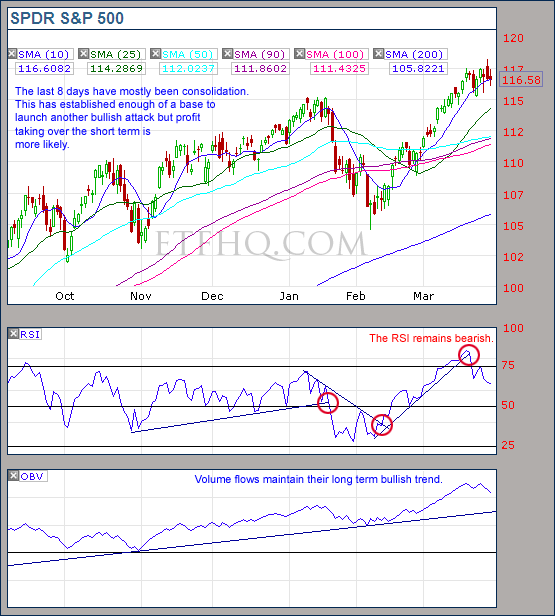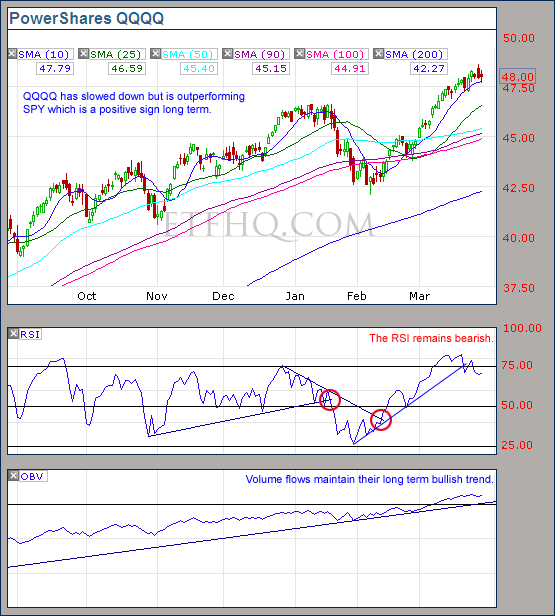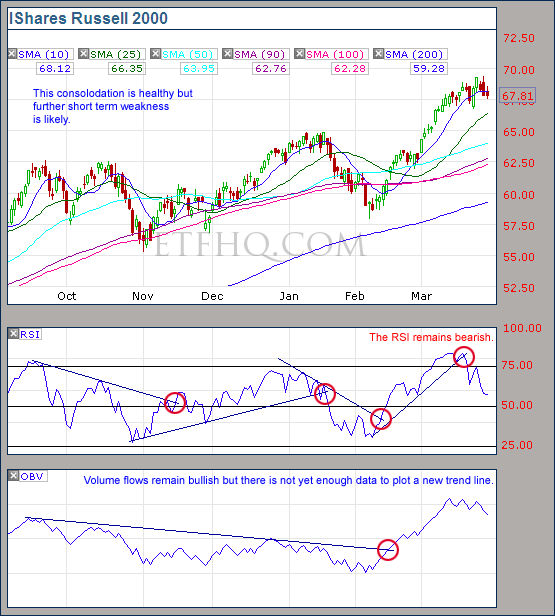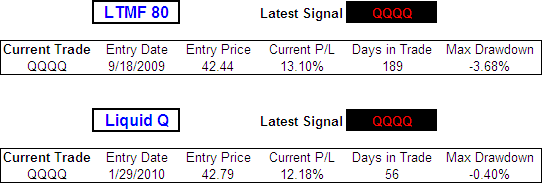March 29, 2010 – 08:35 am ET
The strong advance by the market on Monday and Tuesday took me by surprise and the fact that it was lead by the Semiconductors looked very positive. But by the end of the week most of the gains had been returned.
Really it was a rather uneventful week but without many distractions I have added some new blog posts to elaborate on the philosophies used in these reports. I hope you find them useful.
- The Dow Theory – Truly timeless writings on Technical Analysis
- Trading Psychology – Part 1, Imperative Foundation For Success
- Herd Mentality – Trading Psychology Part 2
- Group Intelligence – Trading Psychology Part 3
.
ETF % Change Comparison
.

SMH was the top performer again over the last week and finally closed above its January high on Tuesday although only just. IYT (Dow Transportation ETF) on the other hand peaked last Thursday and was the only one of the influential ETFs to finish the week lower.
.
What the % Comparison Table Tells Us:
By comparing the performance of the economically sensitive (SMH, QQQQ, IWM, IYT) and the comparatively stable ETFs (SPY and DIA) we can get an indication of the true market direction. The more sensitive areas of the market tend to be the first to initiate a trend change. For example if DIA and SPY sell off heavily while SMH and IWM (Russell 2000 small cap ETF) sell of mildly or continue moving to new highs then this would be very positive and vice versa.
The ‘Average Rank %’ is calculated by subtracting the % change for each ETF from the maximum % change and dividing it by the range for each period. 1-((MAX(% change all ETFs)-ETFs % Change)/(MAX(% change all ETFs)-MIN(% change all ETFs))) The readings for each period are then averaged. This reading is provided because if one ETF was significantly under/out performing the others then a plain high or low rank would not accurately reflect this.
.
![]()
.
A Look at the Charts
.

Short term weakness continues to be the most likely outcome from SPY although we have now established a base from which the next leg could be launched.
.

If QQQQ is to continue moving higher in any meaningful way then SMH will have to rally strongly. Short term weakness is more likely however.
.

I am surprised that SMH has done so well over the last two weeks but the lack of volume behind the move is not a good sign.
.

IWM has had enough consolidation to start another bullish leg but that would require a strong rally from SMH.
.

Like much of the market ITY continues to indicate short term weakness.
.
![]()
.
OM3 Weekly Indicator
.

All signals are positive here although IWM has been on a strong buy signal for the last 7 weeks while the average signal lasts for only 6 weeks.
.
How to read the OM3 indicator
The OM3 indicator as with most of our models primarily reads price action and volume. The strong/weak buy/sell signals are self-explanatory. ‘No Signal’ means that the component readings are in conflict and cancel each other out.
The alerts let you know if the cycle is speeding up or slowing down, so when you get at ‘Strong Buy, Bear Alert’ for instance it simply means that the criteria for a strong buy is in place but this weeks cycle reading is weaker (or more bearish) than last weeks reading (the same is true in reverse).
The number of weeks that a signal has been repeated is displayed. Historically a ‘Strong Buy’ signal has lasted for an average of 6 weeks and a maximum of 42 weeks, while a ‘Strong Sell’ has lasted for an average of 4 weeks and a maximum of 16.
This is an indicator not a mechanical trading model. It is useful to assist in analyzing the market but for the best results should be combined with commonsense and support/resistance levels etc.
.
![]()
.
TransDow & NasDow
.

The Dow Transportation Index remains dominant over the Dow while the Dow remains dominant over the NASDAQ. It would be better to see the NASDAQ regain dominance.
.
What the TransDow Readings tell us:
The TransDow measures dominance between the DJ Transportation Index (DJTI) and the Dow Jones Industrial Average (DJIA). In a strong market the more economically sensitive Transportation Index should be dominant over the DJIA.
Historically the DJTI has been dominant over the Dow 45% of the time. The annualized rate of return from the DJTI during this period was 18.47% with the biggest loss for one trade sitting at -13.27%. The annualized return from the DJIA during the periods it was dominant over the DJTI was just 4.06% and the biggest loss for one trade was -16.13%. A 4% stop-loss is applied to all trades adjusting positions only at the end of the week.
What the NasDow Readings tell us:
The NasDow measures dominance between the NASDAQ and the DJIA. Using the same theory behind the Trans Dow; in a strong market the more economically sensitive NASDAQ should be dominant over the DJIA.
Historically the NASDAQ has been dominant over the DJIA 44% of the time. Taking only the trades when the NASDAQ is above its 40 week moving average the annualized rate of return was 25.47% with the biggest loss for one trade sitting at –8.59%. The annualized rate on the DJIA during the periods it was dominant over the NASDAQ is just 8.88% and the biggest loss for one trade was –12.28%. A 8% stop-loss is applied to all trades adjusting positions only at the end of the week.
.
![]()
.
LTMF 80 & Liquid Q
.

Both LTMF 80 and Liquid Q remain on buy signals for QQQQ. Internal readings from Liquid Q have weakened and it would not take much to trigger a sell signal.
.
Historical Stats:
.

.
How The LTMF 80 Works
LTMF stands for Long Term Market Forecaster. It reads volume flows relative to price action and looks for out performance of volume measured on a percentage basis over the prior 12 months. During a sustained rally the readings will reach high levels (near 100%) making it imposable for the volume reading to always outperform price so any reading above 80% will maintain the buy signal. This system has outperformed the market over the last 10 years but performance has been damaged by some nasty losses. It only produces buy signals and only for QQQQ.
How Liquid Q Works
Liquid Q completely ignores price action and instead measures the relative flow of money between a selection of economically sensitive and comparatively stable ares of the market. It looks for times when the smart money is confident and and can be seen by through volume investing heavily is more risky areas due to an expectation of expansion. This system has outperformed the market over the last 10 years and remained in cash through most of the major declines. It only produces buy signals and only for QQQQ. We will provide more performance details on the web site for these systems soon.
.
![]()
.
Summary
.
Over the last two weeks the market has seen enough consolidation to start a new leg higher. But for that to happen SMH would have to be the one leading the market. The more likely outcome is further weakness over the short term. There are currently no indications that anything more sinister is brewing so any declines should be seen as buying opportunities.
.
Any disputes, questions, queries, comments or theories are most welcome in the comments section below.
.
Derry
And the Team @ ETF HQ
.
P.S Thank you for sharing this newsletter, we grow primarily through word of mouth. Please direct people to ETFHQ.com to subscribe.
P.P.S Become a fan of ETFHQ on Facebook – HERE
.
![]()
.
The Devils Dictionary – F
.
Fees – The raison d’etre of Wall Street. The means by which wealth is transferred from its owners to those entrusted to manage it. See investment banks, private equity, hedge funds, rating agencies, money managers, etc.
Financial Engineering – Whereas conventional engineering seeks to take weak structures and make them solid, financial engineering aims at the opposite.
Fitch – What you say to your dog after you throw the bone of the last steak your family will eat for the foreseeable future.